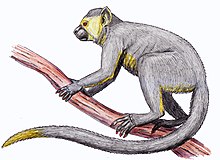| Eosimias | |
|---|---|

| |
| Restoration of E. sinensis | |
| Scientific classification | |
| Domain: | Eukaryota |
| Kingdom: | Animalia |
| Phylum: | Chordata |
| Class: | Mammalia |
| Order: | Primates |
| Suborder: | Haplorhini |
| Infraorder: | Simiiformes |
| Family: | †Eosimiidae |
| Genus: | †Eosimias Beard et al., 1994 |
| Species[1] | |
| |
Eosimias is a genus of early primates, first discovered and identified in 1999 from fossils collected in the Shanghuang fissure-fillings of Liyang, the southern city of Jiangsu Province, China. It is a part of the family Eosimiidae, and includes three known species: Eosimias sinensis, Eosimias centennicus, and Eosimias dawsonae.[3] It provides us with a glimpse of a primate skeleton similar to that of the common ancestor of the Haplorhini (including all simians). The name Eosimias is designed to mean "dawn monkey", from Greek eos "dawn" and Latin simius "monkey".[4]
Dating has proven this genus lived from 45 to 40 million years ago in the middle Eocene.[4] The genus Eosimias is unique because of the presence of primitive and derived traits. It provides new insight into the phylogenetic relationships between simians and prosimians (especially the phylogenetic position of the haplorhine prosimian tarsiers). It can best be described as a likely tree dweller that relied on a steady diet of insects and nectar.
Most eosimiid species are documented by unique or fragmentary specimens. This, as well as the strong belief that simians originated in Africa has made it difficult for many[who?] to accept the idea that Asia played a role in early primate evolution. Although some continue to challenge the anthropoid resemblances found in Eosiimidae, extensive anatomical evidence collected over the past decade substantiates its anthropoid status.[citation needed]
- ^ a b "Eosimias". paleobiodb.org. Retrieved 2021-07-28.
- ^ Cite error: The named reference
:0was invoked but never defined (see the help page). - ^ Beard, K.C.; Qi, T.; Dawson, M.R.; Wang, B. & Li, C. (1994). "A diverse new primate fauna from middle Eocene fissure-fillings in southeastern China". Nature. 368 (6472): 604–609. Bibcode:1994Natur.368..604B. doi:10.1038/368604a0. PMID 8145845. S2CID 2471330.
- ^ a b "Tracking Our Extended Family". Carnegie Mellon’s Museum of Natural History. Archived from the original on July 6, 2010. Retrieved 2010-08-09.